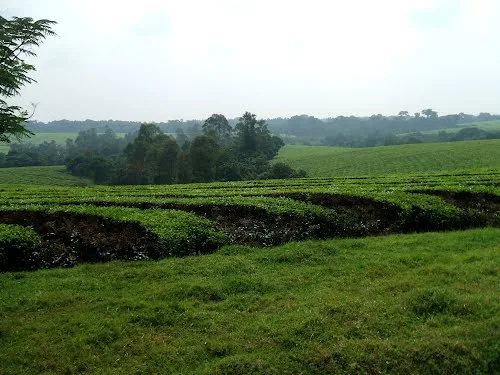Tea and Africa
Tea, one of the oldest and most consumed beverages worldwide, has a rich and diverse history intertwined with the culture, economy, and geography of numerous countries. Africa, with its vast expanse and climatic variability, offers ideal conditions for tea cultivation in several regions, becoming a significant producer in the global scene. This report focuses on tea production in Africa, highlighting the most important countries in terms of production, the varieties of tea produced, and the most relevant markets for its commercialization.

Tea Production in Africa
Tea production in Africa has expanded considerably in recent decades, with several countries emerging as key producers. Among these, Kenya stands out as the undisputed leader, followed by Malawi, Uganda, Tanzania, and Morocco. These countries benefit from favorable climatic conditions, suitable altitudes, and fertile soils, contributing to the distinctive quality and flavor of their teas.
Varieties of Tea Produced in Africa
African tea production encompasses a variety of teas, including black, green, and herbal teas, each with its own unique characteristics and flavors.
- Black Tea: This is the most widely produced and consumed type of tea in Africa. Black teas are fully oxidized and have a strong, bold flavor. Kenyan black teas, known for their rich, brisk taste and bright color, are particularly famous.
- Green Tea: Although less common than black tea, green tea production is growing in some African countries. Green teas are not oxidized and are known for their fresh, grassy flavors. Moroccan green tea, often served with mint and sugar, is a popular variety.
- Herbal Teas: Africa is also home to a variety of herbal teas, made from indigenous plants7. Rooibos, or red bush tea, native to South Africa, is a popular herbal tea known for its sweet, nutty flavor and health benefits. It is caffeine-free and contains antioxidants.
Kenya: The African Tea Giant
Kenya is the largest tea producer in Africa and one of the leading global producers. Tea production in Kenya is concentrated in the highland areas west of the Rift Valley, where the humid climate and rich volcanic soils provide an ideal environment for cultivation. Kenyan tea is known for its intense red color, strong flavor, and vibrant aroma, making it a favorite in international markets.
Other African Tea Producers
- Malawi and Uganda: These countries have developed a robust tea industry, producing high-quality varieties that competitively stand in the global market. Malawi and Ugandan teas are valued for their unique flavor and full-bodied character.
- Tanzania and Morocco: Although their production is smaller compared to Kenya, Tanzania and Morocco have managed to establish themselves on the world tea map. Morocco, in particular, is famous for its mint tea, a traditional blend that reflects the rich tea culture of North Africa.
Important Markets for African Tea
Global demand for tea continues to grow, driven by its recognized nutritional value and health benefits7. The most important markets for African tea include:
- Europe: Traditionally, European countries have been the main importers of African tea, especially from Kenya. The United Kingdom, France, and Germany are key destinations, where African tea is appreciated for its quality and flavor.
- United States: Demand for tea in the United States has significantly increased in recent decades, offering a growing market opportunity for African producers. American consumers show a growing interest in specialty and organic teas, areas where Africa can excel.
- Asia: Although Asia is more known as a tea-producing region, it also represents an important market for African tea. Countries like China and Japan, with an established tea culture, are open to exploring tea varieties from new regions.
Challenges and Opportunities
Tea production in Africa faces several challenges, including the volatility of world market prices, the effects of climate change, and the need to modernize cultivation and processing practices. However, there are significant opportunities to improve quality and diversify products, as well as to penetrate new markets.
Tea production in Africa plays a crucial role in the economy of several countries, providing employment and contributing to exports. As global demand for tea continues to grow, Africa has the potential to increase its market share, especially by focusing on the production of high-quality and organic teas.
| Country Name | Tea Production (in tonnes) | Varieties of Tea |
|---|---|---|
| Kenya | 432,400 | Black, Green, Purple |
| Malawi | 50,000 | Black, Green |
| Uganda | 65,000 | Black, Green |
| Tanzania | 28,500 | Black, Green |
| Zimbabwe | 14,000 | Black, Green |
| Rwanda | 33,000 | Black, Green |
| South Africa | 20,000 | Rooibos, Honeybush |
| Ethiopia | 15,000 | Ethiopian tea (various types) |
| Zambia | 10,000 | Black, Green |
| Burundi | 11,200 | Black, Green |
Sources
-
- Food and Agriculture Organization of the United Nations (FAO). (2022). Production Yearbook.
- International Tea Committee. (2021). World Tea Production and Trade.
-
United Nations Comtrade Database. (2022). International Trade Statistics.
-
World Bank Group. (2022). World Development Indicators.
-
International Journal of Scientific and Research Publications. (2021). A Review on African Tea Industry.
-
African Tea Producers Association. (2022). African Tea Industry Overview.

Team ProdAfrica
team@profafrica.com